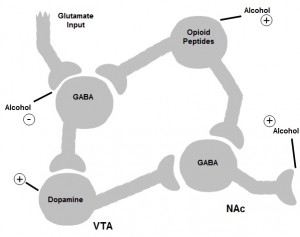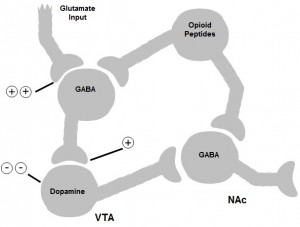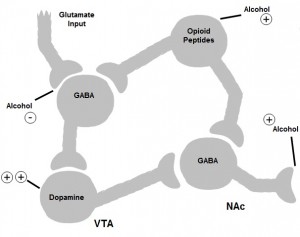At the Circuit Level…
While alcohol’s isolated affect on Glutamate, GABA, and endogenous opioid neurotransmission is important to understand, it is really the combined effects of these three forms of neurotransmission that help to explain the larger picture of ethanol’s effect on the body.
Acute exposure
-The increase of beta-endorphins inhibits GABAergic neurotransmission in the Ventral Tagmental Area (VTA) and the Nucleus Accumbens (NAc). In addition, alcohol non-competititvely inhibits Glutamatergic transmission, further inhibiting GABAergic neurons in the VTA. This lack of GABAergic neurotransmission in the VTA leads to increased Dopamine release from the VTA to the NAc. This process also leads to the sensitization of dopamine neurons to the the presence of alcohol.
-The overall result of acute alcohol exposure is reduced GABAergic neurotransmission and increased dopamine release within the NAc–this is when the reward pathway takes over.
-After chronic exposure, this same system makes it difficult to quit drinking and facilitates the relapse behaviors often seen in those individual’s that become physically dependent on ethanol.
Chronic exposure (physical dependence)
-When an individual attempts to quit, glutamatergic neurotransmission is increased to GABAergic neurons (due to their upregulation) resulting in decreased dopamine release in the NAc in the acute absence of ethanol. Moreover, the activity of the dopamine neurons is already reduced as these neurons have become desensitized in the absence of alcohol.
-This decrease in dopamine from alcohol-supplemented levels as well as the overexcitation of glutamatergic neurontransmission are the main causes of withdrawal symtoms.
-These withdrawal symptoms include:
- sleep disturbances
- high degree of arousal (tremors, anxiety, elevated B.P., etc.)
- seizure/cellular hyperexcitability
- toxic psychosis (irritability, headaches, fever, nausea, hallucinations)
Relapse
-When alcohol is reintroduced to the system, typically to abate these symptoms, the same mechanism is in play that mediates acute exposure with the addition of increased sensitivity of dopamine neurons to the presence of alcohol.
-The overall result is an even larger release of dopamine in the NAc which is the main reason alcohol addiction is so difficult to overcome. This mechanism makes individuals vulnerable to continuous relapse behavior which has the potential to induce habit formation–turning the addiction into a non-voluntary response.
*If you are interested in learning more about the neurobiological basis for alcohol addiction, on both the level of the synapse and the circuit, you can find the more detailed information that was used to make this page here and here.


